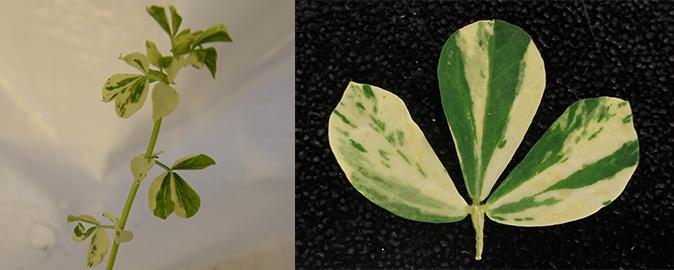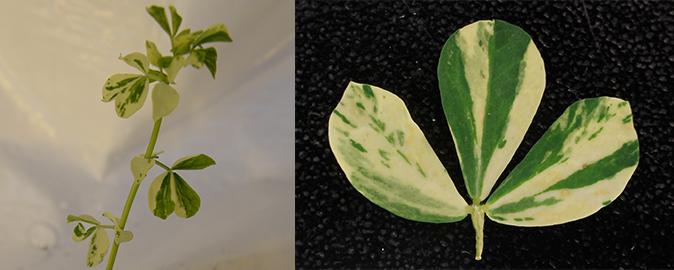
Credit: Niels Sandal, Aarhus University
Garden and potted plants with white spots on their leaves are so popular that they are specially selected for this feature. An international research team has now identified a new mutation in the plant Lotus japonicus which gives leaves with white spots. These results could be important for the improvement of garden and potted plants.
Only few plant mutations are known to give plants with white spots on their leaves, and they are known primarily in the small plant thale cress (arabidopsis), and hence plant breeders are interested in developing new types.
In the plant molecular group at the Department of Molecular Biology and Genetics in Aarhus, the researchers have succeeded in finding a new mutation that can give the white spots. They have a collection of more than 100,000 plant lines (lotus.au.dk) where a so-called retrotransposon has inserted new copies in the genome, thus creating mutations. The retrotransposon has spontaneously become active in Lotus japonicus, which the research group uses as a model plant in their studies. The group has identified where new copies of the retrotransposon have entered the genome in the different lines. However, the mutants are smaller as they have not developed chloroplasts in the white spots, where they cannot use the energy from sunlight to build up their sugars.
By screening this population for mutants with an interesting appearance, two lines were found that gave beautiful spotty leaves. The researchers were able to identify the mutation behind this appearance. The mutation was found in the snowy cotyledon 2 gene (Sco2). A mutant in the corresponding gene from arabidopsis is already known, but here it was only known that — as the mutant name Snowy Cotyledon indicates — it results in white cotyledons (the first two leaves).
International collaboration led to results
The Danish researchers then established a collaboration with researchers who are experts in photosynthesis and chloroplasts at the University of Copenhagen and Ludwig Maximilians Universität, Munich. They were able to show that when growing the corresponding mutant from arabidopsis under conditions of light for a few hours, the leaves became much smaller. In addition to the lack of chlorophyll and carotenoids, some of the photosynthesis proteins in the sco2 mutants were also sparse.
Some of the proteins in the chloroplast are made from hereditary genes in the chloroplast itself, while other proteins (such as Sco2) are made from the DNA in the nucleus of the plant cell and then imported into the chloroplast. Previously, the predominant theory has been that the spotty leaves occur due to an imbalance between the amount of particular chloroplastic proteins encoded in the nucleus and chloroplastic proteins encoded in the chloroplast. The sco2 mutant does not seem to fit into this theory. Therefore, new ideas must be developed on how the spotty leaves in the sco2 mutant occur.
In addition to the sco2 mutant, other new Lotus japonicus mutants with spotty leaves have been isolated in Aarhus, which in the future will be used to give a more complete picture of how spotty leaves occur in plants. It may indicate new ways for the improvement of ornamental plants. Chloroplast proteins are crucial to the growth of all plants, so the results are also relevant for understanding how chloroplasts function in general.
The scientific article was been published in the journal Molecular Plant, 10, 721-734.
###
Media Contact
Senior Researcher Niels Sandal
[email protected]
45-20-76-00-42
@aarhusuni
http://www.au.dk
############
Story Source: Materials provided by Scienmag





